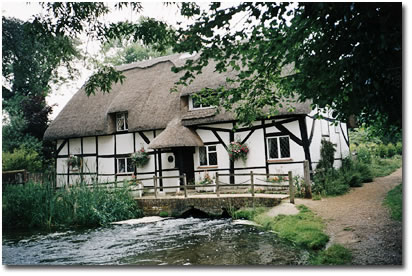|
|
|
|
|
|
 |
 |
|
|
| 9th
Infantry Division — World
War II — Alresford and
Winchester, England |
|
|
|
 |
 |
 |
 |
 |
 |
 |
|
The
Fulling Mill is located on
the River Arle in Alresford,
England
|
Alresford,
England, is a quaint village located
approximately seven miles east of
Winchester. From November 1943 to
May 1944, the 9th Infantry Division
was stationed in Alresford, Tichborne,
Cheriton, Armsworth House, Bighton
Wood, Bishop Sutton, Basingstoke and
Northington Grange, which at that
time was the largest home in England
aside from Buckingham Palace in London.
The 39th "Fighting Falcons"
were stationed at Camp Barton Stacey,
a former British installation, while
the 60th "Go-Devils" were
billetted at Winchester and Bushfield.
Having conquered the Axis powers in
North Africa, Tunisia and Sicily,
9th Infantry Division GIs were traveling
to England for rest and relaxation
and, of course, more training for
the war's next big event — seizure
of Hitler's Atlantic Wall during the
June 1944 D-Day landings on the shores
of Normandy, France. The 9th Infantry
Division would begin unloading at
Utah Beach on D-Day-plus-four, June
10, 1944.
While stationed in England, GIs enjoyed
plenty of pubs and bitter beer, tea
and scones, fish and chips (at that
time eaten from a newspaper wrapper
and doused with vinegar and salt),
and an abundance of beautiful British
ladies. In Alresford, troops revelled
in walks along the River Arle, sometimes
with a canine mascot known as Hambone
Jr.
Pictured here is the Alresford Fulling
Mill on the River Arle. According
to Stephen
Alsford's Web site, the Fulling
Mill was rebuilt in the 13th century
for the fulling of cloth.
"Access to clean, fast-running
water was a requirement of this element
of the cloth-finishing industry and
much of the mill is built directly
above the river," Alsford wrote
at his Web site. "The great pond
created by (Bishop Godfrey de Lucy's)
weir supplied a source of fast-running
water for the operation of mills.
"England's wool was known throughout
medieval Europe for its quality (although
that of southern England was not the
finest produced in the country), and
the wool and cloth trades were a major
element in the English economy from
the twelfth to the fifteenth century.
At first it was the export of raw
wool to cloth-producing centres of
Flanders and Italy that was important,
particularly in the earlier period,
as a growing population across Europe
produced greater demand for clothing.
"English merchants and entrepreneurs
came to realize the sense in using
the wool to produce cloth domestically
(rather than buy it back from Europe).
They invested in the development of
an existing, modest, rural cloth-producing
industry (with a corresponding adverse
effect on the elements of that industry
already established in the larger
towns); many fulling mills were built
in the thirteenth century. Cloth manufacture
employed a large number of townsmen
in its various stages (e.g. shearing,
carding, combing, spinning, weaving,
fulling, felting, dyeing, cutting).
Fulling was a two-part process:
"1. newly-woven cloth was cleaned
by soaking it in clean water and then
beating it, usually with water-driven
mechanical paddles; 2. the cloth was
thickened by scrubbing it with 'fuller's
earth' (aluminium oxide) which provided
a good texture and initiated bleaching,
a process later completed by the cloth-owners
who stretched the cloth out to dry
over a wooden frame called a 'tenter'."
[ Back
to Photographs • Next
Photograph ]
|
 |
 |
 |
|
|
 |
|
 |
|
|
|
|
|
|
|
|
|
 |
 |
|
